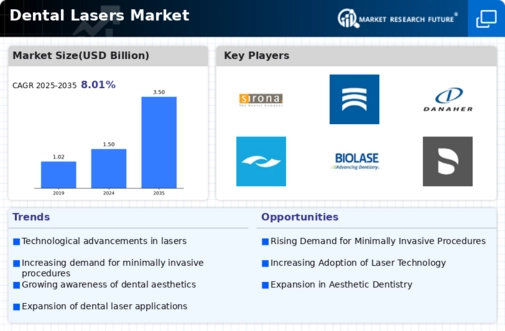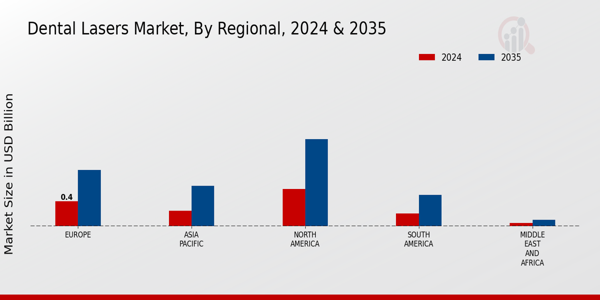Dental Lasers Size
Dental Lasers Market Growth Projections and Opportunities
The dental lasers market is influenced by several key factors that shape its dynamics and growth trajectory. One crucial factor is technological advancements. As technology evolves, dental laser devices become more sophisticated, efficient, and user-friendly. Innovations such as improved wavelengths, pulse durations, and delivery systems enhance the precision and effectiveness of dental laser procedures, driving market growth.
Another significant factor is the increasing prevalence of dental disorders and oral health issues globally. With rising awareness about oral hygiene and the growing aging population, the demand for dental treatments, including laser-based procedures, is on the rise. Dental lasers offer minimally invasive alternatives to traditional surgical methods, attracting patients seeking less painful and quicker recovery options.
Moreover, regulatory factors play a vital role in shaping the dental lasers market landscape. Regulatory bodies establish guidelines and standards for the development, manufacturing, and usage of dental laser devices to ensure patient safety and efficacy. Compliance with regulatory requirements is essential for market players to gain approval for their products and access global markets, impacting market dynamics and competition.
Additionally, reimbursement policies and healthcare infrastructure significantly influence the adoption of dental laser technologies. Reimbursement schemes for dental laser procedures vary across different regions and healthcare systems, affecting affordability and accessibility for patients. Moreover, the availability of trained professionals and infrastructure for delivering laser-based dental treatments influences market penetration and growth opportunities.
Market competition and dynamics among key players also drive innovation and market expansion in the dental lasers segment. Companies invest in research and development activities to introduce advanced laser technologies and gain a competitive edge. Strategic collaborations, mergers, and acquisitions are common in the market, allowing companies to broaden their product portfolios and geographical presence, thereby intensifying market competition.
Furthermore, economic factors such as disposable income levels, healthcare expenditure, and reimbursement policies impact the affordability and adoption of dental laser treatments. In emerging economies, the growing middle-class population and increasing healthcare spending contribute to market growth opportunities. However, economic downturns and financial constraints may hinder the adoption of expensive dental laser procedures, particularly in regions with limited healthcare resources.
Consumer preferences and awareness also play a crucial role in shaping the dental lasers market. Patients are increasingly seeking minimally invasive and painless treatment options, driving demand for laser-based dental procedures. Dental practitioners and clinics are responding to these preferences by investing in advanced laser technologies and promoting their benefits to patients, thereby fueling market growth.
Moreover, ongoing research and development initiatives aimed at expanding the applications of dental lasers contribute to market expansion. Scientists and dental professionals are exploring new indications and techniques for utilizing lasers in various dental specialties, such as periodontics, endodontics, and implantology. These advancements broaden the scope of dental laser treatments and create new revenue opportunities for market players.














Leave a Comment